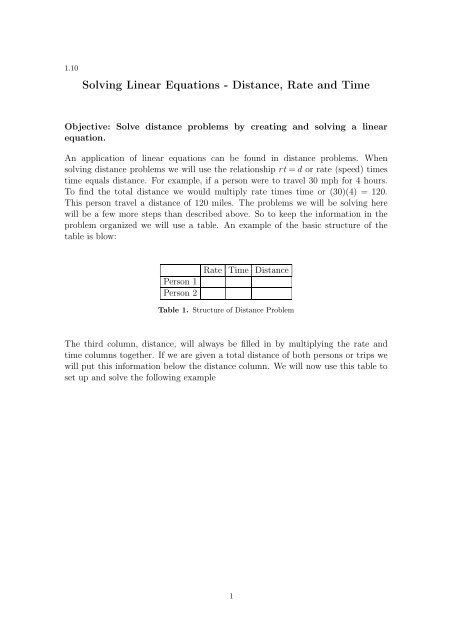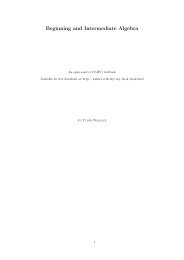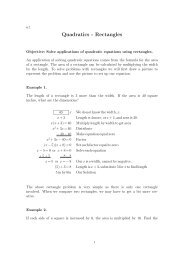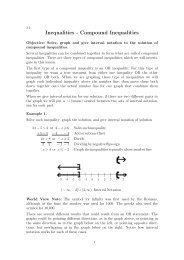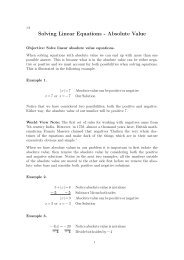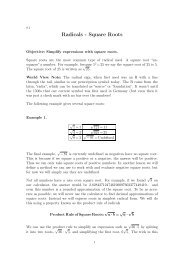Solving Linear Equations - Distance, Rate and Time - Wallace Math ...
Solving Linear Equations - Distance, Rate and Time - Wallace Math ...
Solving Linear Equations - Distance, Rate and Time - Wallace Math ...
Create successful ePaper yourself
Turn your PDF publications into a flip-book with our unique Google optimized e-Paper software.
1.10<br />
<strong>Solving</strong> <strong>Linear</strong> <strong>Equations</strong> - <strong>Distance</strong>, <strong>Rate</strong> <strong>and</strong> <strong>Time</strong><br />
Objective: Solve distance problems by creating <strong>and</strong> solving a linear<br />
equation.<br />
An application of linear equations can be found in distance problems. When<br />
solving distance problems we will use the relationship rt = d or rate (speed) times<br />
time equals distance. For example, if a person were to travel 30 mph for 4 hours.<br />
To find the total distance we would multiply rate times time or (30)(4) = 120.<br />
This person travel a distance of 120 miles. The problems we will be solving here<br />
will be a few more steps than described above. So to keep the information in the<br />
problem organized we will use a table. An example of the basic structure of the<br />
table is blow:<br />
Person 1<br />
Person 2<br />
<strong>Rate</strong> <strong>Time</strong> <strong>Distance</strong><br />
Table 1. Structure of <strong>Distance</strong> Problem<br />
The third column, distance, will always be filled in by multiplying the rate <strong>and</strong><br />
time columns together. If we are given a total distance of both persons or trips we<br />
will put this information below the distance column. We will now use this table to<br />
set up <strong>and</strong> solve the following example<br />
1
Example 1.<br />
Two joggers start from opposite ends of an 8 mile course running towards each<br />
other. One jogger is running at a rate of 4 mph, <strong>and</strong> the other is running at a<br />
rate of 6 mph. After how long will the joggers meet?<br />
Jogger1<br />
Jogger2<br />
<strong>Rate</strong> <strong>Time</strong> <strong>Distance</strong><br />
<strong>Rate</strong> <strong>Time</strong> <strong>Distance</strong><br />
Jogger1 4<br />
Jogger2 6<br />
<strong>Rate</strong> <strong>Time</strong> <strong>Distance</strong><br />
Jogger1 4 t<br />
Jogger2 6 t<br />
<strong>Rate</strong> <strong>Time</strong> <strong>Distance</strong><br />
Jogger1 4 t 4t<br />
Jogger2 6 t 6t<br />
The basic table for the joggers, one <strong>and</strong> two<br />
We are given the rates for each jogger.<br />
These are added to the table<br />
We only know they both start <strong>and</strong> end at the<br />
same time. We use the variable t for both times<br />
The distance column is filled in by multiplying<br />
rate by time<br />
8 We have total distance, 8 miles, under distance<br />
4t + 6t=8 The distance column gives equation by adding<br />
10t=8 Combine like terms, 4t + 6t<br />
10 10 Divide both sides by 10<br />
t= 4<br />
5<br />
Our solution fort, 4<br />
5<br />
hour(48 minutes)<br />
As the example illustrates, once the table is filled in, the equation to solve is very<br />
easy to find. This same process can be seen in the following example<br />
Example 2.<br />
Bob <strong>and</strong> Fred start from the same point <strong>and</strong> walk in opposite directions. Bob<br />
walks 2 miles per hour faster than Fred. After 3 hours they are 30 miles apart.<br />
How fast did each walk?<br />
<strong>Rate</strong> <strong>Time</strong> <strong>Distance</strong><br />
Bob 3<br />
Fred 3<br />
The basic table with given times filled in<br />
Both traveled3hours<br />
2
<strong>Rate</strong> <strong>Time</strong> <strong>Distance</strong><br />
Bob r + 2 3<br />
Fred r 3<br />
<strong>Rate</strong> <strong>Time</strong> <strong>Distance</strong><br />
Bob r + 2 3 3r + 6<br />
Fred r 3 3r<br />
Bob walks 2 mph faster than Fred<br />
We know nothing about Fred, so use r for his rate<br />
Bob isr + 2, showing 2 mph faster<br />
<strong>Distance</strong> column is filled in by multiplying rate by<br />
<strong>Time</strong>. Be sure to distribute the3(r +2) for Bob.<br />
30 Total distance is put under distance<br />
3r + 6+3r = 30 The distance columns is our equation, by adding<br />
6r +6=30 Combine like terms 3r + 3r<br />
− 6 − 6 Subtract6from both sides<br />
<strong>Rate</strong><br />
Bob 4+2=6<br />
Fred 4<br />
6r = 24 The variable is multiplied by 6<br />
6 6 Divide both sides by 6<br />
r =4 Our solution for r<br />
To answer the question completely we plug 4 in for<br />
r in the table. Bob traveled6miles per hour <strong>and</strong><br />
Fred traveled4mph<br />
Some problems will require us to do a bit of work before we can just fill in the<br />
cells. One example of this is if we are given a total time, rather than the individual<br />
times like we had in the previous example. If we are given total time we<br />
will write this above the time column, use t for the first person’s time, <strong>and</strong> make<br />
a subtraction problem, Total − t, for the second person’s time. This is shown in<br />
the next example<br />
Example 3.<br />
Two campers left their campsite by canoe <strong>and</strong> paddled downstream at an average<br />
speed of 12 mph. They turned around <strong>and</strong> paddled back upstream at an average<br />
rate of 4 mph. The total trip took 1 hour. After how much time did the campers<br />
turn around downstream?<br />
<strong>Rate</strong> <strong>Time</strong> <strong>Distance</strong><br />
Down 12<br />
Up 4<br />
<strong>Rate</strong> <strong>Time</strong> <strong>Distance</strong><br />
Down 12 t<br />
Up 4 1 − t<br />
Basic table for down <strong>and</strong> upstream<br />
Given rates are filled in<br />
1 Total time is put above time column<br />
As we have the total time, in the first time we have<br />
t, the second time becomes the subtraction,<br />
total −t<br />
3
<strong>Rate</strong> <strong>Time</strong> <strong>Distance</strong><br />
Down 12 t 12t<br />
Up 4 1 −t 4 − 4t<br />
=<br />
<strong>Distance</strong> column is found by multiplying rate<br />
by time. Be sure to distribute4(1 −t) for<br />
upstream. As they cover the same distance,<br />
= is put after the down distance<br />
12t = 4 − 4t With equal sign, distance colum is equation<br />
+ 4t + 4t Add4t toboth sides sovariableis onlyon one side<br />
16t =4 Variable is multiplied by 16<br />
16 16 Divide both sides by 16<br />
t = 1<br />
4<br />
Our solution, turn around after 1<br />
hr(15 min )<br />
4<br />
Another type of a distance problem where we do some work is when one person<br />
catches up with another. Here a slower person has a head start <strong>and</strong> the faster<br />
person is trying to catch up with him or her <strong>and</strong> we want to know how long it<br />
will take the fast person to do this. Our startegy for this problem will be to use t<br />
for the faster person’s time, <strong>and</strong> add amount of time the head start was to get the<br />
slower person’s time. This is shown in the next example.<br />
Example 4.<br />
Mike leaves his house traveling 2 miles per hour. Joy leaves 6 hours later to catch<br />
up with him traveling 8 miles per hour. How long will it take her to catch up<br />
with him?<br />
<strong>Rate</strong> <strong>Time</strong> <strong>Distance</strong><br />
Mike 2<br />
Joy 8<br />
<strong>Rate</strong> <strong>Time</strong> <strong>Distance</strong><br />
Mike 2 t + 6<br />
Joy 8 t<br />
<strong>Rate</strong> <strong>Time</strong> <strong>Distance</strong><br />
Mike 2 t+6 2t+12<br />
Joy 8 t 8t<br />
=<br />
Basic table for Mike <strong>and</strong> Joy<br />
The given rates are filled in<br />
Joy, the faster person, we use t for time<br />
Mike ′ s time ist+6showing his 6 hour head start<br />
<strong>Distance</strong> column is found by multiplying the rate<br />
by time. Be sure to distribute the 2(t +6) for Mike<br />
As they cover the same distance,=is put after<br />
Mike ′ s distance<br />
2t + 12 =8t Now the distance column is the equation<br />
− 2t − 2t Subtract2t from both sides<br />
12 =6t The variable is multiplied by 6<br />
6 6 Divide both sides by 6<br />
2 =t Our solution fort, she catches him after 2 hours<br />
4
World View Note: The 10,000 race is the longest st<strong>and</strong>ard track event. 10,000<br />
meters is approximately 6.2 miles. The current (at the time of printing) world<br />
record for this race is held by Ethiopian Kenenisa Bekele with a time of 26 minutes,<br />
17.53 second. That is a rate of 12.7 miles per hour!<br />
As these example have shown, using the table can help keep all the given information<br />
organized, help fill in the cells, <strong>and</strong> help find the equation we will solve. The<br />
final example clearly illustrates this.<br />
Example 5.<br />
On a 130 mile trip a car travled at an average speed of 55 mph <strong>and</strong> then reduced<br />
its speed to 40 mph for the remainder of the trip. The trip took 2.5 hours. For<br />
how long did the car travel 40 mph?<br />
<strong>Rate</strong> <strong>Time</strong> <strong>Distance</strong><br />
Fast 55<br />
Slow 40<br />
<strong>Rate</strong> <strong>Time</strong> <strong>Distance</strong><br />
Fast 55 t<br />
Slow 40 2.5 − t<br />
<strong>Rate</strong><br />
2.5<br />
<strong>Time</strong> <strong>Distance</strong><br />
Fast 55 t 55t<br />
Slow 40 2.5 −t 100 − 40t<br />
Basic table for fast <strong>and</strong> slow speeds<br />
The given rates are filled in<br />
2.5 Total time is put above the time column<br />
As we have total time, the first time we have t<br />
The second time is the subtraction problem<br />
2.5 −t<br />
<strong>Distance</strong> column is found by multiplying rate<br />
by time. Be sure to distribute 40(2.5 −t) for slow<br />
130 Total distance is put under distance<br />
55t + 100 − 40t=130 Thedistancecolumngivesourequationbyadding<br />
15t + 100 = 130 Combine like terms 55t − 40t<br />
− 100 − 100 Subtract 100 from both sides<br />
<strong>Time</strong><br />
Fast 2<br />
Slow 2.5 − 2=0.5<br />
15t=30 The variable is multiplied by 30<br />
15 15 Divide both sides by 15<br />
t=2 Our solution fort.<br />
To answer the question we plug 2 in fort<br />
The car traveled 40 mph for 0.5 hours (30 minutes)<br />
Beginning <strong>and</strong> Intermediate Algebra by Tyler <strong>Wallace</strong> is licensed under a Creative Commons<br />
Attribution 3.0 Unported License. (http://creativecommons.org/licenses/by/3.0/)<br />
5
1.10 Practice - <strong>Distance</strong>, <strong>Rate</strong>, <strong>and</strong> <strong>Time</strong> Problems<br />
1. A is 60 miles from B. An automobile at A starts for B at the rate of 20 miles<br />
an hour at the same time that an automobile at B starts for A at the rate of<br />
25 miles an hour. How long will it be before the automobiles meet?<br />
2. Two automobiles are 276 miles apart <strong>and</strong> start at the same time to travel<br />
toward each other. They travel at rates differing by 5 miles per hour. If they<br />
meet after 6 hours, find the rate of each.<br />
3. Two trains travel toward each other from points which are 195 miles apart.<br />
They travel at rate of 25 <strong>and</strong> 40 miles an hour respectively. If they start at the<br />
same time, how soon will they meet?<br />
4. A <strong>and</strong> B start toward each other at the same time from points 150 miles apart.<br />
If A went at the rate of 20 miles an hour, at what rate must B travel if they<br />
meet in 5 hours?<br />
5. A passenger <strong>and</strong> a freight train start toward each other at the same time from<br />
two points 300 miles apart. If the rate of the passenger train exceeds the rate<br />
of the freight train by 15 miles per hour, <strong>and</strong> they meet after 4 hours, what<br />
must the rate of each be?<br />
6. Two automobiles started at the same time from a point, but traveled in<br />
opposite directions. Their rates were 25 <strong>and</strong> 35 miles per hour respectively.<br />
After how many hours were they 180 miles apart?<br />
7. A man having ten hours at his disposal made an excursion, riding out at the<br />
rate of 10 miles an hour <strong>and</strong> returning on foot, at the rate of 3 miles an hour.<br />
Find the distance he rode.<br />
6
8. A man walks at the rate of 4 miles per hour. How far can he walk into the<br />
country <strong>and</strong> ride back on a trolley that travels at the rate of 20 miles per hour,<br />
if he must be back home 3 hours from the time he started?<br />
9. A boy rides away from home in an automobile at the rate of 28 miles an hour<br />
<strong>and</strong> walks back at the rate of 4 miles an hour. The round trip requires 2 hours.<br />
How far does he ride?<br />
10. A motorboat leaves a harbor <strong>and</strong> travels at an average speed of 15 mph<br />
toward an isl<strong>and</strong>. The average speed on the return trip was 10 mph. How far<br />
was the isl<strong>and</strong> from the harbor if the total trip took 5 hours?<br />
11. A family drove to a resort at an average speed of 30 mph <strong>and</strong> later returned<br />
over the same road at an average speed of 50 mph. Find the distance to the<br />
resort if the total driving time was 8 hours.<br />
12. As part of his flight trainging, a student pilot was required to fly to an airport<br />
<strong>and</strong> then return. The average speed to the airport was 90 mph, <strong>and</strong> the<br />
average speed returning was 120 mph. Find the distance between the two<br />
airports if the total flying time was 7 hours.<br />
13. A, who travels 4 miles an hour starts from a certain place 2 hours in advance<br />
of B, who travels 5 miles an hour in the same direction. How many hours<br />
must B travel to overtake A?<br />
14. A man travels 5 miles an hour. After traveling for 6 hours another man starts<br />
at the same place, following at the rate of 8 miles an hour. When will the<br />
second man overtake the first?<br />
15. A motorboat leaves a harbor <strong>and</strong> travels at an average speed of 8 mph toward<br />
a small isl<strong>and</strong>. Two hours later a cabin cruiser leaves the same harbor <strong>and</strong><br />
travels at an average speed of 16 mph toward the same isl<strong>and</strong>. In how many<br />
hours after the cabin cruiser leaves will the cabin cuiser be alongside the<br />
motorboat?<br />
16. A long distance runner started on a course running at an average speed of 6<br />
mph. One hour later, a second runner began the same course at an average<br />
speed of 8 mph. How long after the second runner started will the second<br />
runner overtake the first runner?<br />
17. A car traveling at 48 mph overtakes a cyclist who, riding at 12 mph, has had<br />
a 3 hour head start. How far from the starting point does the car overtake<br />
the cyclist?<br />
18. A jet plane traveling at 600 mph overtakes a propeller-driven plane which has<br />
had a 2 hour head start. The propeller-driven plane is traveling at 200 mph.<br />
How far from the starting point does the jet overtake the propeller-driven<br />
7
plane?<br />
19. Two men are traveling in opposite directions at the rate of 20 <strong>and</strong> 30 miles an<br />
hour at the same time <strong>and</strong> from the same place. In how many hours will they<br />
be 300 miles apart?<br />
20. Running at an average rate of 8 m/s, a sprinter ran to the end of a track <strong>and</strong><br />
then jogged back to the starting point at an average rate of 3 m/s. The<br />
sprinter took 55 s to run to the end of the track <strong>and</strong> jog back. Find the<br />
length of the track.<br />
21. A motorboat leaves a harbor <strong>and</strong> travels at an average speed of 18 mph to an<br />
isl<strong>and</strong>. The average speed on the return trip was 12 mph. How far was the<br />
isl<strong>and</strong> from the harbor if the total trip took 5 h?<br />
22. A motorboat leaves a harbor <strong>and</strong> travels at an average speed of 9 mph toward<br />
a small isl<strong>and</strong>. Two hours later a cabin cruiser leaves the same harbor <strong>and</strong><br />
travels at an average speed of 18 mph toward the same isl<strong>and</strong>. In how many<br />
hours after the cabin cruiser leaves will the cabin cruiser be alongside the<br />
motorboat?<br />
23. A jet plane traveling at 570 mph overtakes a propeller-driven plane that has<br />
had a 2 h head start. The propeller-driven plane is traveling at 190 mph.<br />
How far from the starting point does the jet overtake the propeller-driven<br />
plane?<br />
24. Two trains start at the same time from the same place <strong>and</strong> travel in opposite<br />
directions. If the rate of one is 6 miles per hour more than the rate of the<br />
other <strong>and</strong> they are 168 miles apart at the end of 4 hours, what is the rate of<br />
each?<br />
25. As part of flight traning, a student pilot was required to fly to an airport <strong>and</strong><br />
then return. The average speed on the way to the airport was 100 mph, <strong>and</strong><br />
the average speed returning was 150 mph. Find the distance between the two<br />
airports if the total flight time was 5 h.<br />
26. Two cyclists start from the same point <strong>and</strong> ride in opposite directions. One<br />
cyclist rides twice as fast as the other. In three hours they are 72 miles apart.<br />
Find the rate of each cyclist.<br />
27. A car traveling at 56 mph overtakes a cyclist who, riding at 14 mph, has had<br />
a 3 h head start. How far from the starting point does the car overtake the<br />
cyclist?<br />
28. Two small planes start from the same point <strong>and</strong> fly in opposite directions.<br />
The first plan is flying 25 mph slower than the second plane. In two hours<br />
the planes are 430 miles apart. Find the rate of each plane.<br />
8
29. A bus traveling at a rate of 60 mph overtakes a car traveling at a rate of 45<br />
mph. If the car had a 1 h head start, how far from the starting point does<br />
the bus overtake the car?<br />
30. Two small planes start from the same point <strong>and</strong> fly in opposite directions.<br />
The first plane is flying 25 mph slower than the second plane. In 2 h, the<br />
planes are 470 mi apart. Find the rate of each plane.<br />
31. A truck leaves a depot at 11 A.M. <strong>and</strong> travels at a speed of 45 mph. At noon,<br />
a van leaves the same place <strong>and</strong> travels the same route at a speed of 65 mph.<br />
At what time does the van overtake the truck?<br />
32. A family drove to a resort at an average speed of 25 mph <strong>and</strong> later returned<br />
over the same road at an average speed of 40 mph. Find the distance to the<br />
resort if the total driving time was 13 h.<br />
33. Three campers left their campsite by canoe <strong>and</strong> paddled downstream at an<br />
average rate of 10 mph. They then turned around <strong>and</strong> paddled back<br />
upstream at an average rate of 5 mph to return to their campsite. How long<br />
did it take the campers to canoe downstream if the total trip took 1 hr?<br />
34. A motorcycle breaks down <strong>and</strong> the rider has to walk the rest of the way to<br />
work. The motorcycle was being driven at 45 mph, <strong>and</strong> the rider walks at a<br />
speed of 6 mph. The distance from home to work is 25 miles, <strong>and</strong> the total<br />
time for the trip was 2 hours. How far did the motorcycle go before if broke<br />
down?<br />
35. A student walks <strong>and</strong> jogs to college each day. The student averages 5 km/hr<br />
walking <strong>and</strong> 9 km/hr jogging. The distance from home to college is 8 km,<br />
<strong>and</strong> the student makes the trip in one hour. How far does the student jog?<br />
36. On a 130 mi trip, a car traveled at an average speed of 55 mph <strong>and</strong> then<br />
reduced its speed to 40 mph for the remainder of the trip. The trip took a<br />
total of 2.5 h. For how long did the car travel at 40 mph?<br />
37. On a 220 mi trip, a car traveled at an average speed of 50 mph <strong>and</strong> then<br />
reduced its average speed to 35 mph for the remainder of the trip. The trip<br />
took a total of 5 h. How long did the car travel at each speed?<br />
38. An executive drove from home at an average speed of 40 mph to an airport<br />
where a helicopter was waiting. The executive boarded the helicopter <strong>and</strong><br />
flew to the corporate offices at <strong>and</strong> average speed of 60 mph. The entire<br />
distance was 150 mi. The entire trip took 3 h. Find the distance from the<br />
airport to the corporate offices.<br />
Beginning <strong>and</strong> Intermediate Algebra by Tyler <strong>Wallace</strong> is licensed under a Creative Commons<br />
Attribution 3.0 Unported License. (http://creativecommons.org/licenses/by/3.0/)<br />
9
1.10<br />
1) 1 1<br />
3<br />
2) 25 1 1<br />
, 20<br />
2 2<br />
3) 3<br />
4) 10<br />
5) 30, 45<br />
6) 3<br />
7) 300<br />
13<br />
8) 10<br />
9) 7<br />
10) 30<br />
11) 150<br />
12) 360<br />
13) 8<br />
Answers - <strong>Distance</strong>, <strong>Rate</strong>, <strong>and</strong> <strong>Time</strong> Problems<br />
14) 10<br />
15) 2<br />
16) 3<br />
17) 48<br />
18) 600<br />
19) 6<br />
20) 120<br />
21) 36<br />
22) 2<br />
23) 570<br />
24) 24, 18<br />
25) 300<br />
26) 8, 16<br />
27) 56<br />
28) 95, 120<br />
29) 180<br />
30) 105, 130<br />
31) 2:15 PM<br />
32) 200<br />
33) 1<br />
3<br />
34) 15<br />
35) 27<br />
4<br />
36) 1<br />
2<br />
37) 3, 2<br />
38) 90<br />
Beginning <strong>and</strong> Intermediate Algebra by Tyler <strong>Wallace</strong> is licensed under a Creative Commons<br />
Attribution 3.0 Unported License. (http://creativecommons.org/licenses/by/3.0/)<br />
10


